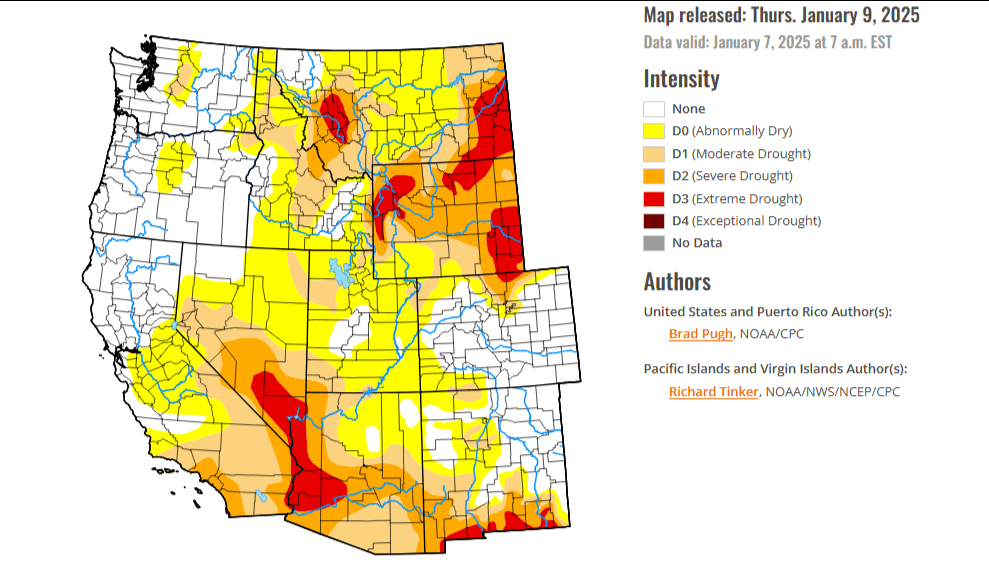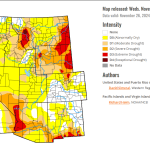- Drought deepens in southern California and the Southwest.
- Southwestern Colorado sees worsening dryness.
- La Niña conditions may influence weather into spring.
January 10, 2025 — A new drought update issued yesterday by the U.S. Drought Monitor shows much of the Colorado River Basin locked in an escalating struggle with dryness. Southern California and the desert Southwest are among the hardest-hit areas, while parts of southwestern Colorado also face deteriorating conditions. Meanwhile, La Niña has finally arrived in the tropical Pacific, and forecasters say it could shape winter and spring weather patterns across Arizona, California, Colorado, Nevada, New Mexico, Utah, and Wyoming.
shows much of the Colorado River Basin locked in an escalating struggle with dryness. Southern California and the desert Southwest are among the hardest-hit areas, while parts of southwestern Colorado also face deteriorating conditions. Meanwhile, La Niña has finally arrived in the tropical Pacific, and forecasters say it could shape winter and spring weather patterns across Arizona, California, Colorado, Nevada, New Mexico, Utah, and Wyoming.
Drought Intensifies in the Southwest.
According to the U.S. Drought Monitor , “The NDMC short-term blend, 90-day SPI [Standard Precipitation Index], and many 28-day average streamflows below the 10th percentile supported the addition of severe drought (D2) to portions of southern California.” Experts warn that the Santa Ana winds will likely worsen these newly intensified drought conditions in the coming weeks. Neighboring areas in Arizona and New Mexico are also seeing drought creep further, fueled by sparse precipitation and above-normal temperatures.
, “The NDMC short-term blend, 90-day SPI [Standard Precipitation Index], and many 28-day average streamflows below the 10th percentile supported the addition of severe drought (D2) to portions of southern California.” Experts warn that the Santa Ana winds will likely worsen these newly intensified drought conditions in the coming weeks. Neighboring areas in Arizona and New Mexico are also seeing drought creep further, fueled by sparse precipitation and above-normal temperatures.
Colorado’s southwest corner is feeling the pinch, too. Analysts note that minimal early-season snowpack, combined with continued dryness, prompted a downgrade in drought status there. With below-normal snowfall extending into parts of the Four Corners region, soil moisture remains low, creating worries for water supplies that feed local communities and agriculture.
La Niña’s Late Arrival.
Over at Climate.gov , researchers confirm that “La Niña conditions emerged in the tropical Pacific in December. There’s a 59% chance La Niña will persist through February–April, followed by a 60% chance of neutral conditions in March–May.” They explain that La Niña is one phase of the larger El Niño/Southern Oscillation (ENSO), “a pattern of sea surface temperature and atmospheric changes in the tropical Pacific Ocean.”
, researchers confirm that “La Niña conditions emerged in the tropical Pacific in December. There’s a 59% chance La Niña will persist through February–April, followed by a 60% chance of neutral conditions in March–May.” They explain that La Niña is one phase of the larger El Niño/Southern Oscillation (ENSO), “a pattern of sea surface temperature and atmospheric changes in the tropical Pacific Ocean.”
Though this La Niña appeared later than anticipated, it is still expected to influence temperature and precipitation patterns. Typically, a La Niña winter can mean drier and warmer conditions for parts of the southern tier of the United States. These shifts can reinforce drought tendencies in places already reeling from below-normal rainfall and limited snowpack.
A Challenging Outlook.
Experts caution that the months ahead could remain challenging unless a series of winter storms deliver widespread moisture. Reservoir levels—crucial in the Colorado River Basin—will likely come under further stress without meaningful precipitation. Water managers, farmers, and local officials will keep a close eye on snowpack accumulation in the higher elevations through the remainder of winter.
As the U.S. Drought Monitor and Climate.gov continue tracking conditions, all eyes remain on whether La Niña will break down as quickly as predicted or hang on into the spring. Either way, staying informed on evolving drought trends will be critical for everyone who depends on the Colorado River Basin’s strained resources.
Image Source: U.S. Drought Monitor





Leave a Reply